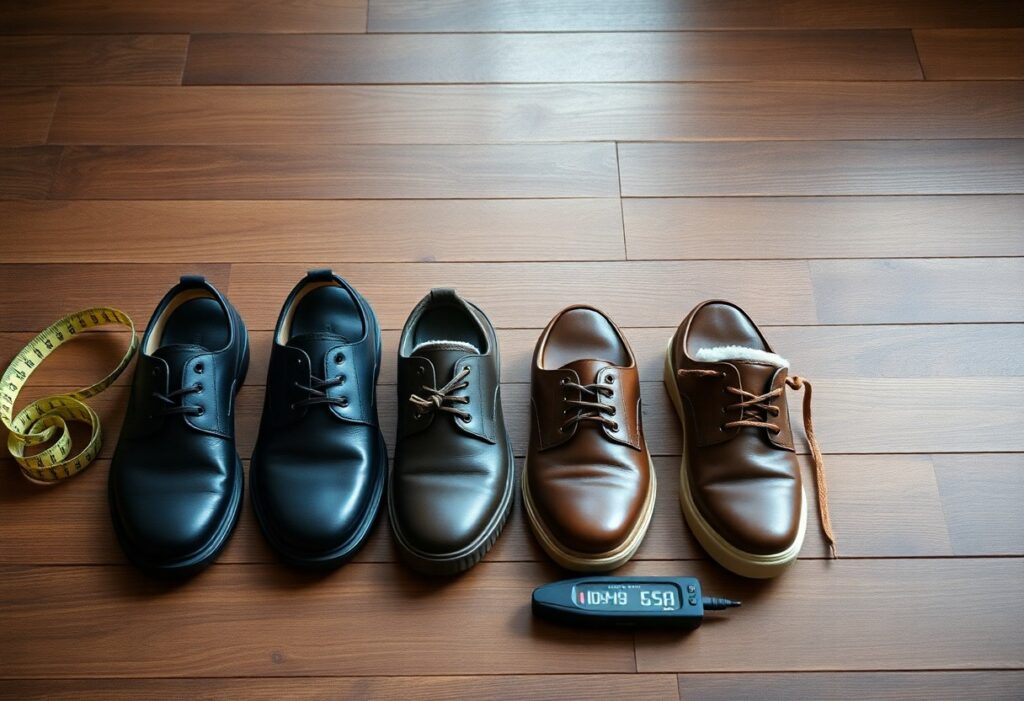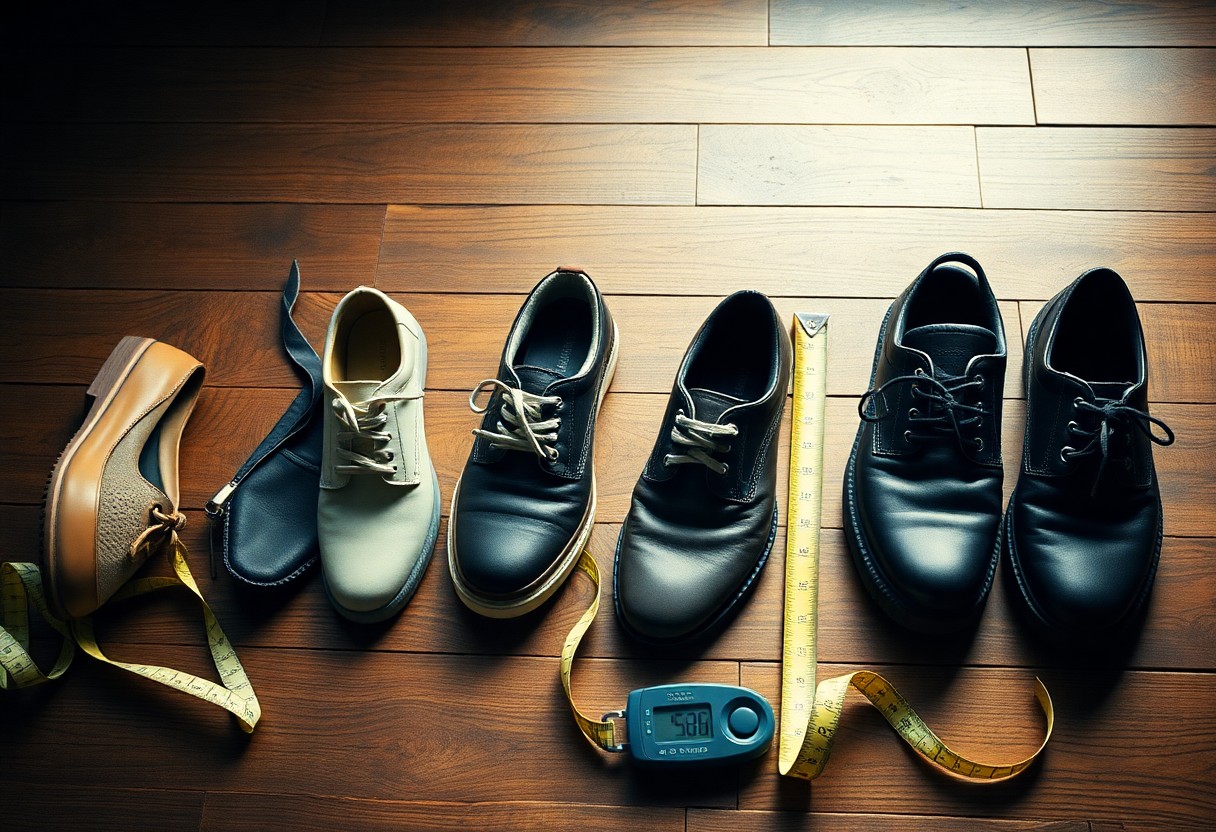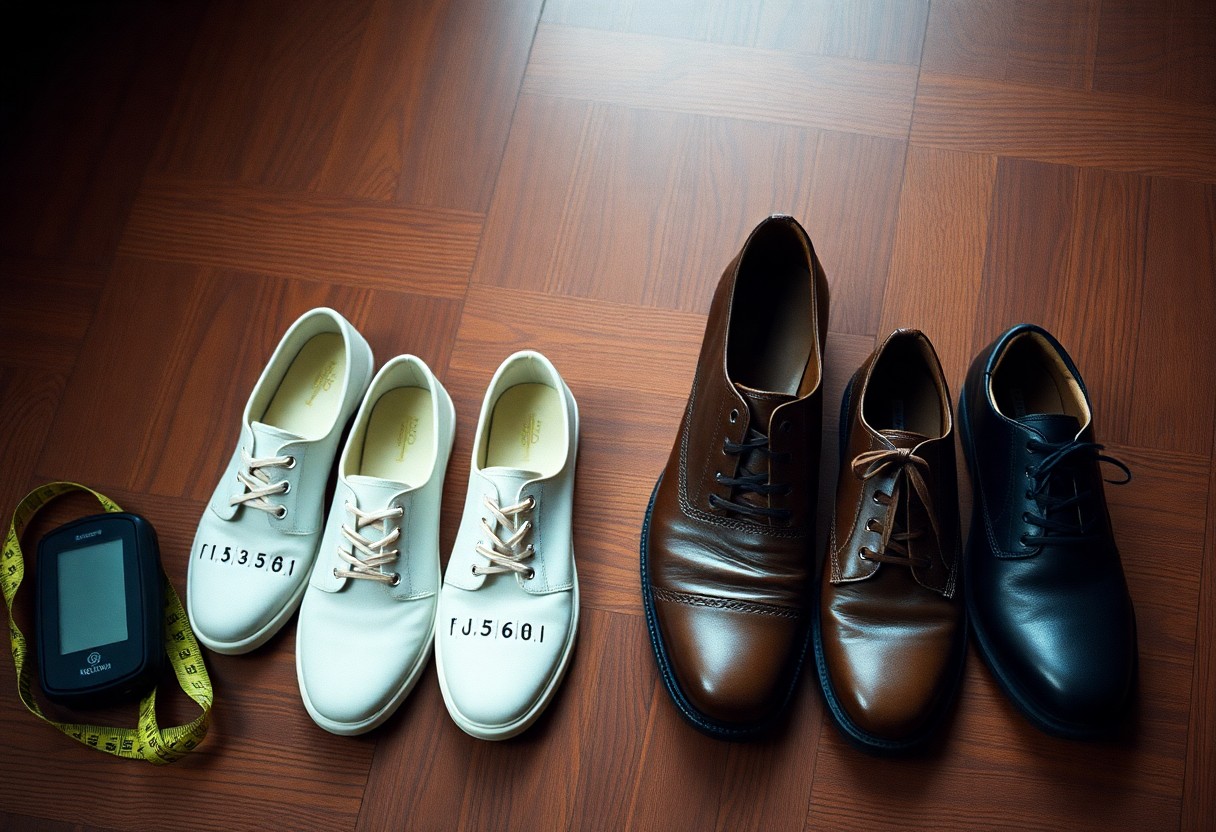
Understanding the significance of selecting shoes with the optimal width is crucial for safeguarding your overall foot health and ensuring daily comfort. Wearing footwear that fits appropriately can greatly mitigate foot pain and prevent various health issues. When purchasing shoes, it is imperative to evaluate both the length and width to secure a proper fit. Choosing shoes that align with your foot's width not only improves your stability and blood circulation but also decreases the likelihood of developing blisters and other common foot ailments. To determine your ideal shoe width, measure the broadest part of your foot and consult standardized width charts. Many consumers mistakenly prioritize length, overlooking the fact that adequate width is equally essential for everyday comfort and foot health.
Steps to Measure Your Feet for the Perfect Shoe Fit
The most reliable technique for assessing your shoe width involves measuring your feet later in the day when they are likely to be slightly swollen. Foot width can vary by as much as half an inch throughout the day, so evening measurements tend to yield the most accurate results. To accomplish this, stand on a sheet of paper and trace around your foot, ensuring you capture the most precise measurements possible. This straightforward process can help you identify shoes that not only fit well but also deliver the comfort and support your feet require for daily activities.
Accurate Methods for Measuring Foot Width
Beyond using a standard ruler, consider employing a Brannock Device, a specialized tool found in most shoe stores that accurately measures foot size. This device enables you to assess the widest part of your foot, typically located across the ball area. For the best outcomes, it’s essential to measure both feet while standing, as it is common for one foot to be slightly larger than the other. This practice ensures that you select shoes that accommodate the larger foot, thus preventing discomfort during wear and enhancing your overall experience.
How to Avoid Common Mistakes in Shoe Width Selection
A prevalent mistake when choosing shoe width is underestimating the importance of width measurements. Many individuals tend to focus exclusively on length, which can lead to discomfort and an array of potential foot complications. Other common pitfalls include measuring feet while seated and mistakenly believing that your foot width remains unchanged throughout your life. It is vital to understand that wearing shoes that are too narrow can result in serious foot issues like bunions, corns, and hammertoes. Additionally, foot size can change due to factors such as weight fluctuations, pregnancy, or aging, making it advisable to measure your feet annually. Selecting the appropriate width can help prevent blisters, calluses, and persistent foot pain.

Comprehending Shoe Width Systems and Standards for the Best Fit
Gaining familiarity with various shoe width systems is essential for ensuring comfort and maintaining foot health. Different brands and countries utilize unique measurement standards, so understanding these systems can aid in selecting shoes that fit correctly and avoid foot complications. By comprehending how width is categorized, you can make informed decisions when choosing footwear that aligns with your specific needs.
Decoding Letter-Based Width Scales for Improved Shoe Fitting
When browsing for shoes, you’ll typically encounter widths labeled from AA to EE. For women, the standard medium width is B, while for men it is D. Narrow widths range from AA to B, whereas wide widths extend from D to EE. This letter-based system is designed to assist you in identifying the right fit based on your foot shape, ensuring that your shoes feel comfortable and provide the necessary support for your daily activities.
Global Width Measurement Standards and Their Importance
When shopping in the international market, you may come across various measurement systems. For example, European sizes are based on millimeters, while UK sizes adhere to their own width standards. Your US shoe size may differ from international sizing by one to two width sizes. Therefore, it is crucial to always refer to the brand’s size chart when purchasing shoes from abroad. Japanese shoes tend to run narrower, while European brands often feature a wider toe box. To ensure the best fit, measuring your feet in millimeters provides the most precise reference for international purchases.

Exploring How Shoe Construction Influences Fit and Comfort
To make the most suitable footwear choices for your feet, it’s vital to understand the different elements that comprise shoe construction. The way a shoe is designed significantly impacts how it fits and feels during wear. Your overall comfort is influenced by the connection between the upper part of the shoe and the sole, as well as the flexibility of the materials surrounding your foot's widest area. By opting for shoes with thoughtful construction, you can significantly enhance your comfort and support throughout the day.
The Advantages of Natural Materials in Footwear Choices
Shoes crafted from genuine leather offer remarkable breathability and flexibility. Leather possesses a natural ability to stretch and adapt to the contours of your foot over time, resulting in a customized fit. Studies indicate that leather footwear can expand by up to 30% of its original width, making it an excellent choice for individuals with varying foot widths who prioritize comfort and a tailored feel.
The Durability and Consistency of Synthetic Shoe Materials
Synthetic materials available in today’s market provide consistent width measurements and exceptional durability. These modern materials protect your feet while also offering water resistance and enhanced breathability. Many synthetic shoes now incorporate mesh panels, promoting airflow and flexibility. Furthermore, advancements in synthetic materials have introduced comfort features such as memory foam and gel inserts. Consequently, shoes can now seamlessly blend stable width measurements with targeted cushioning, delivering outstanding support during wear. Recent research shows that synthetic materials can preserve their shape up to 40% longer than traditional materials, ensuring your shoes maintain their proper width over their lifespan.

Recognizing Signs of Proper Shoe Width for Ultimate Comfort
Unlike shoe length, appropriate width is often reflected in how your feet feel and function while wearing them. Your shoes should provide enough room for your toes to spread comfortably while walking, ideally with about half an inch of space at the widest point. Research indicates that 70% of individuals wear shoes that are improperly fitted in width, resulting in a variety of foot-related issues. Being able to identify the signs of proper width can empower you to make smarter footwear choices.
Essential Indicators of Comfort from Correct Shoe Width
Here are key indicators that your shoes fit appropriately in terms of width: your toes should be able to wiggle without restriction, the ball of your foot should align with the shoe’s widest part, and you should not experience any pinching or squeezing on the sides. A well-fitting shoe allows your feet to expand naturally throughout the day, as feet can swell by up to 8% by the end of the day, making it essential to ensure a comfortable fit.
Identifying Warning Signs of Incorrect Shoe Width
During regular wear, it’s essential to be aware of warning signs such as numbness or tingling in your toes, blisters developing on the sides of your feet, and pressure marks on your skin after removing your shoes. These symptoms may indicate that your shoes are either too narrow or too wide for your feet. Proper width is critical for maintaining foot health, as studies demonstrate that ill-fitting shoes can lead to long-term foot complications. You should feel no pressure points while standing or walking; if you experience pain, redness, or if your foot overflows the edges of the shoe, it’s time to reassess your width selection.
Understanding Width Variations Among Different Brands
Many shoe manufacturers provide a range of width options, spanning from AA (super narrow) to 4E (extra wide). It’s important to acknowledge that foot width can fluctuate throughout the day, with studies indicating that up to 70% of individuals have different widths between their left and right foot. Understanding these variations will assist you in selecting shoes that cater to your unique foot shape and help prevent discomfort and potential foot complications.
The Influence of Brand Differences on Shoe Width Measurements
When comparing different brands, you may observe notable discrepancies in width measurements. A medium width in one brand might feel narrow in another. European brands often have narrower fits compared to American brands, while athletic footwear companies frequently offer the most extensive variety of width options. It’s always advisable to try on shoes before making a purchase, as sizes can vary greatly between manufacturers, and finding the right fit is essential for comfort.
How Shoe Style Affects Width Fitting
The style of the shoe significantly impacts how width accommodates your foot. Athletic shoes generally allow for more width flexibility compared to dress shoes, while sandals are designed to facilitate a more natural width. Your requirements for foot width may shift based on the shoe’s intended purpose and the activities you plan to undertake. Further analysis indicates that certain styles require specific width considerations. For example, high heels necessitate a secure fit to prevent slipping, while work boots might need additional width to comfortably fit thicker socks. Running shoes should provide about half an inch of space between your longest toe and the shoe’s tip for optimal comfort and performance.
Identifying Special Width Needs for Unique Foot Conditions
While standard sizing options are widely available, some individuals may need specific width accommodations. If you have conditions such as bunions, flat feet, or experience swelling, wider shoes may be necessary. Additionally, foot width can change as the day progresses, with studies indicating a potential 4% increase in foot volume by evening. Recognizing these variations is crucial for selecting shoes that remain comfortable throughout your daily activities.
Medical Conditions That Require Special Width Accommodations
Special width needs often arise from various medical conditions. For individuals with diabetes, arthritis, or edema, it is vital to wear shoes that offer extra width allowance for proper circulation. Healthcare professionals may recommend specific width measurements to prevent complications associated with these conditions. Research reveals that 75% of individuals with foot ailments benefit from specialized width fittings, underscoring the necessity of suitable footwear.
Activity-Specific Width Requirements for Optimal Performance
An active lifestyle necessitates different shoe widths for various activities. For instance, your running shoes may require more width than your everyday footwear, while hiking boots should accommodate thicker socks comfortably. Athletes typically benefit from shoes that are half a size to a full size wider for high-impact sports, allowing for natural foot expansion during intense activities. When considering activity-specific fitting, take into account your foot’s natural movement patterns. For example, during running, your feet can spread up to half a size wider. In sports requiring lateral movements, such as tennis or basketball, adequate width is critical to prevent foot strain and potential injuries. Your footwear choices should align with your activity level and unique foot characteristics for the best results.
Discovering Your Ideal Shoe Width for Lasting Comfort
Finding your ideal shoe width hinges on understanding proper measurement techniques and available width options. By measuring your feet at their broadest point, identifying your width category (ranging from A to E), and selecting shoes that match your measurements, you can ensure enduring comfort. The shoes should fit snugly without pinching or sliding, allowing your toes the flexibility to move naturally. By opting for the correct width and choosing materials that cater to your foot's needs, you can enjoy comfortable, well-fitting footwear that supports your daily endeavors.
Your Questions Answered: Shoe Width FAQs
Q: What’s the best way to measure my foot width at home accurately?
A: To accurately measure your foot width, place your foot on a blank sheet of paper and trace its outline carefully. Measure the widest part, typically located at the ball of your foot, using a ruler. It’s best to take measurements in the afternoon when your feet are at their largest. Don’t forget to measure both feet, as it’s common for one to be wider than the other. Use these measurements to compare against shoe width charts provided by manufacturers for the best fit.
Q: What are the standard width classifications for shoes?
A: Shoe widths generally utilize letter codes ranging from A to E. For women, the standard medium width is B, while for men, it’s D. Narrow widths are represented by A and AA, while C and D indicate medium-wide for women. E and EE denote wide widths. Be mindful that each brand may have slight variations in their width measurements, so it’s advisable to consult their specific size charts before making a purchase.
Q: How can I determine if my current shoes have the wrong width?
A: Look for these signs: red marks on the sides of your feet, numbness in your toes, blisters on your heels or sides, and shoes that slip off while walking. Your toes should have ample space to wiggle freely, and the ball of your foot should fit comfortably at the shoe’s widest part. If you feel pressure on the sides, it’s time to consider a wider shoe. Conversely, if your foot moves side-to-side within the shoe, you may need a narrower width.
The Article How to choose the right shoe width tips for a comfortable fit appeared first on My Shoes Finder
The Article Choosing the Right Shoe Width for Ultimate Comfort Was Found On https://limitsofstrategy.com


This topic resonates deeply with me, as I have often experienced the repercussions of neglecting shoe width in my quest for stylish footwear. It’s fascinating how something as simple as the right width can have such a profound impact on our overall foot health. I’ve had my share of shoes that looked great but caused discomfort because they didn’t match the natural shape of my feet.
This is such an important topic! I’ve definitely fallen into the trap of obsessing over shoe length while completely ignoring the width. I remember the last pair of sneakers I bought—I was all excited until I realized they pinched my feet by the end of the day. Since then, measuring my feet has become a part of my shoe shopping routine.
I really appreciate your insights on the importance of shoe width—it’s a topic that often flies under the radar for many of us. I used to think that finding the right shoe was solely about length, but after dealing with some significant foot pain, I realized that width plays a crucial role in overall comfort and health.
Ah, the quest for the perfect shoe width—it’s like trying to find your soulmate but with less emotional baggage and more foot-shaped dilemmas. I once bought a pair of “wide” shoes thinking I’d finally be free from blisters, only to discover they were designed for a foot that could practically moonlight as a stunt double in a circus. Who knew foot size had its own personality?
Finding the right shoe width really is a hunt, isn’t it? It’s like shoe brands have their own secret language when it comes to sizing. What’s “wide” for one might as well be “narrow” for another. It’s frustrating trying to decipher these foot-shaped personalities, especially when you think you’ve cracked the code, only to end up in a pair that feels like it was made for someone else entirely.